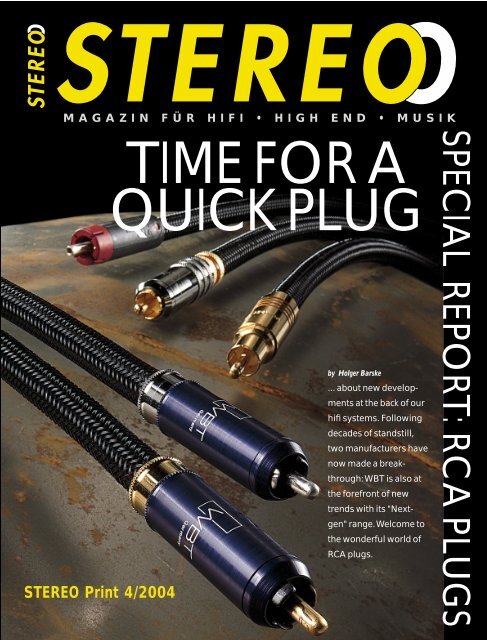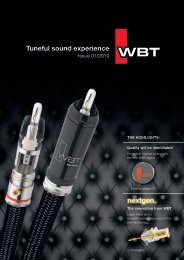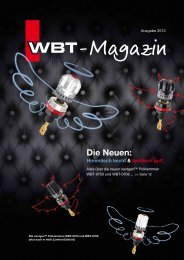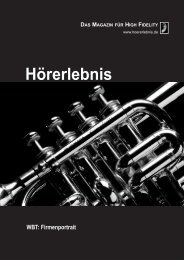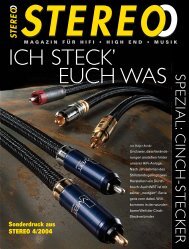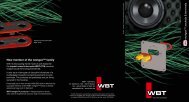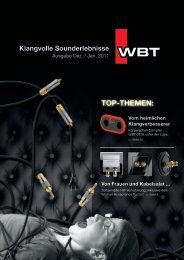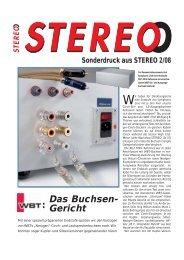Read the article! PDF for download - WBT
Read the article! PDF for download - WBT
Read the article! PDF for download - WBT
You also want an ePaper? Increase the reach of your titles
YUMPU automatically turns print PDFs into web optimized ePapers that Google loves.
MAGAZIN FÜR HIFI • HIGH END • MUSIK<br />
STEREO Print 4/2004<br />
TIME FOR A<br />
QUICK PLUG<br />
by Holger Barske<br />
... about new developments<br />
at <strong>the</strong> back of our<br />
hifi systems. Following<br />
decades of standstill,<br />
two manufacturers have<br />
now made a breakthrough:<br />
<strong>WBT</strong> is also at<br />
<strong>the</strong> <strong>for</strong>efront of new<br />
trends with its "Nextgen"<br />
range. Welcome to<br />
<strong>the</strong> wonderful world of<br />
RCA plugs.<br />
SPECIAL REPORT: RCA PLUGS
Are you looking <strong>for</strong> a sure-fire business<br />
idea? Then you could do a lot<br />
worse than custom cable assembly;<br />
<strong>for</strong> audio interconnect cables to be precise.<br />
Because recent developments mean that<br />
things will never be <strong>the</strong> same in <strong>the</strong> world of<br />
connection technology. Hundreds -<br />
perhaps even thousands - of hifi enthusiasts<br />
will soon be wanting to fit <strong>the</strong>ir audio cables<br />
with new plugs. The reason behind this predicted<br />
euphoria?: <strong>WBT</strong> has developed<br />
a new RCA plug. Its name is<br />
"Nextgen 0110" and, as <strong>the</strong><br />
name suggests, it is designed to<br />
signal a "changing of <strong>the</strong> guard"<br />
in <strong>the</strong> field of hifi connections.<br />
It's not every day that an experienced<br />
physicist like Hans Strassner<br />
from Leverkusen-based cable specialist<br />
HMS calls us and says: "I'm sending you<br />
five audio cables - all identical but fitted<br />
with different plugs. You won't believe your<br />
ears". Suffice it to say that Strassner's prediction<br />
of our reaction was pretty accurate -<br />
in fact, we were totally amazed. But more<br />
about that later.<br />
The RCA plug (also known as <strong>the</strong> cinch<br />
plug) is something like <strong>the</strong> "grand old lady"<br />
of <strong>the</strong> hifi world. It was invented by US<br />
company RCA in 1942 <strong>for</strong> a highly practical<br />
reason: <strong>the</strong> industry needed a low-cost plug<br />
connector to hook <strong>the</strong><br />
newly developed record<br />
player to a suitable amplifier<br />
- which in those days<br />
was more like a radio receiver.<br />
That's why <strong>the</strong> correct<br />
full name of <strong>the</strong> plug<br />
is still "RCA Phono Plug".<br />
There had previously<br />
been no need <strong>for</strong> a plug of<br />
this kind - <strong>the</strong>re was nothing<br />
to hook up to, since<br />
<strong>the</strong> process of music playback<br />
all took place within<br />
one and <strong>the</strong> same appli-<br />
ance.<br />
The success story of <strong>the</strong> RCA plug continues<br />
up to this day - despite <strong>the</strong> blip that<br />
started in late fifties, when <strong>the</strong> standardisation-loving<br />
Germans decided to go <strong>the</strong>ir<br />
own way with <strong>the</strong> "DIN plug", <strong>the</strong> five-pin<br />
Up to <strong>the</strong> present, no standard RCA<br />
connection has been able to transmit<br />
digital signals in a technically<br />
correct manner - in o<strong>the</strong>r words,<br />
without reflections<br />
TEST-CHAIN<br />
CD-Player: Einstein „The<br />
Last Record Player“, Audiomeca<br />
Obsession II<br />
AMPLIFIER: Symphonic Line<br />
RG14 Edition, Cayin TA35S<br />
PRE/POWER AMP: Vincent<br />
SA-93/SP-991 plus, AccuphaseC-2400/P-7000<br />
SPEAKERS: Lumen White<br />
„White Lights“, Odeon Fidelio<br />
CABLE: HMS, Silvercom,<br />
Nordost<br />
Close-up of <strong>the</strong> "central contact<br />
unit" of <strong>the</strong> 0110 showing <strong>the</strong><br />
modular design and <strong>the</strong><br />
punch-bent<br />
contacts<br />
Characteristic impedance<br />
It may be measured in ohms - but it´s not<br />
<strong>the</strong> same as „everyday impedance“<br />
Characteristic impedance is a communicationsrelated<br />
parameter that is by no means easy to<br />
describe. So we're confining ourselves to a rough<br />
explanation of this phenomenon.<br />
Things are fairly simple when it comes to <strong>the</strong><br />
"normal" impedance of resistors: if a<br />
resistor is installed in a circuit, it limits<br />
<strong>the</strong> flow of current and converts <strong>the</strong><br />
resulting power loss into heat.<br />
Characteristic impedance is a far more<br />
complex matter: it can't be purchased in<br />
<strong>the</strong> <strong>for</strong>m of a physical resistor. It is a<br />
design-based parameter of all signalcarrying<br />
components and does not really "burn<br />
off" electrical power. It only comes into play in<br />
<strong>the</strong> high-frequency range when <strong>the</strong> transmission<br />
phenomena extend beyond those phenomena that<br />
are influenced purely by Ohm's law.<br />
The characteristic impedance needs to be matched:<br />
ideally, all <strong>the</strong> parts involved in <strong>the</strong> signal-<br />
Signal transmission<br />
is only<br />
flawless if all<br />
components<br />
are correctly<br />
matched<br />
version of which was a de facto<br />
standard in Europe <strong>for</strong> almost 20<br />
years and which is still favoured<br />
today by some manufacturers (such<br />
as Naim or Phonosophie). Compared to<br />
its international counterpart, <strong>the</strong> advantage<br />
of <strong>the</strong> DIN plug was that it<br />
could point to clearly defined specifications,<br />
whereas RCA plugs were long<br />
characterised by extreme tolerances ranging<br />
from "doesn't even fit in <strong>the</strong> socket" to<br />
"keeps on falling out of <strong>the</strong> socket". These<br />
problems have meanwhile been ironed out,<br />
and plugs and sockets from all over <strong>the</strong><br />
world now generally ensure a good fit -<br />
although it wasn't until 1999 that <strong>the</strong> "official"<br />
dimensions <strong>for</strong> plugs and sockets of<br />
this type were laid down internationally.<br />
An RCA cinch is a coaxial connection: a<br />
thin inner conductor - <strong>the</strong> "hot" pin -<br />
is enclosed by a cylindrical outer conductor<br />
- <strong>the</strong> return conductor or <strong>the</strong> ground<br />
connection. The idea behind <strong>the</strong> concept is<br />
quite simple and consistent: <strong>the</strong> aim was to<br />
continue <strong>the</strong> generally coaxial structure of<br />
<strong>the</strong> connected cables all <strong>the</strong> way through to<br />
<strong>the</strong> plug and socket connection. The<br />
reasons <strong>for</strong> choosing this system are equally<br />
logical: <strong>the</strong> low-impedance ground on <strong>the</strong><br />
outer conductor is designed to serve as an<br />
effective shield <strong>for</strong> <strong>the</strong> weak signal on <strong>the</strong> inner<br />
conductor.<br />
So it was that this connection concept became<br />
generally accepted and relatively problem-free<br />
over a number of decades. It was<br />
carrying process (in our case: output stage,<br />
sockets, plugs, cable and input stage of <strong>the</strong> receiving<br />
unit) should have <strong>the</strong> same level. If this is<br />
not <strong>the</strong> case, <strong>the</strong> electrical signal is not transmitted<br />
with total clarity. Part of it is reflected at <strong>the</strong><br />
transition point, is fed back through <strong>the</strong><br />
cable and makes life difficult <strong>for</strong> <strong>the</strong> "driving<br />
amp", which has to deal with <strong>the</strong>se<br />
reflections. Moreover, this part of <strong>the</strong><br />
energy is missing from <strong>the</strong> amplitude of<br />
<strong>the</strong> useful signal. If <strong>the</strong> various components<br />
involved in <strong>the</strong> transmission process<br />
are correctly matched, exactly half<br />
of <strong>the</strong> feed signal drops off along <strong>the</strong> overall<br />
route and <strong>the</strong>re are no reflections.<br />
Amateur radio hams know all about <strong>the</strong>se interrelationships<br />
between radio unit and antenna and<br />
talk about "standing wave ratio": if this ratio is far<br />
enough from <strong>the</strong> optimum ratio (one to one), it<br />
can sometimes burn up <strong>the</strong> transmitter amp.
not until <strong>the</strong> eighties that <strong>the</strong> high-end afficionados<br />
began to take an interest in phono<br />
plugs, and <strong>the</strong> RCA connector was soon<br />
trans<strong>for</strong>med from a plain-looking practicality<br />
into a shiny chrome and gold primadonna<br />
- a matching component <strong>for</strong> cables<br />
whose prices are meanwhile sometimes far<br />
higher than <strong>the</strong> components <strong>the</strong>y connect.<br />
Ultra-stable, with optimised electrical properties<br />
and as functional as on <strong>the</strong> very first<br />
day after years in use - <strong>the</strong>se are <strong>the</strong> qualities<br />
that are still expected from products in this<br />
segment.<br />
This is not <strong>the</strong> first sign of new developments<br />
in <strong>the</strong> audiophile world in recent<br />
times. A few years ago, a modest-looking<br />
"plastic connector" - <strong>the</strong> "Bullet Plug" from<br />
Australian manufacturer Eichmann - began<br />
to make life difficult <strong>for</strong> <strong>the</strong> established solid<br />
metal connectors on <strong>the</strong> market. STE-<br />
INTERVIEW<br />
„We wantet to make <strong>the</strong><br />
75-ohm RCA connection“<br />
STEREO: Mr. Thörner, what prompted you to<br />
make such a radical break with your previous<br />
product philosophy in <strong>the</strong> segment of RCA<br />
plugs?<br />
Thörner: The differences are not as dramatic<br />
as <strong>the</strong>y might seem. The main elements in <strong>the</strong><br />
<strong>WBT</strong> philosophy are also part of <strong>the</strong> 0110:<br />
such as <strong>the</strong> generation of a high contact pressure<br />
on <strong>the</strong> ground side using a locking clamp<br />
mechanism - and this aspect is even more<br />
important in <strong>the</strong> new concept than in <strong>the</strong> older<br />
models with large-surface contact areas. In<br />
addition, <strong>the</strong> new range of plugs is also fitted<br />
with a sturdy strain relief device, and <strong>the</strong><br />
ample space inside <strong>the</strong> plug enables even nonprofessional<br />
cable customisers to create a perfect<br />
electrical and mechanical cable connection.<br />
Ultimately, however, <strong>the</strong> primary motivation<br />
<strong>for</strong> <strong>the</strong> development of <strong>the</strong> 0110 was a<br />
purely technical one: <strong>the</strong> key objective was to<br />
finally make an RCA connection with a characteristic<br />
impedance of 75 ohms. When we<br />
began working on <strong>the</strong> new concept, we didn't<br />
expect it to possess o<strong>the</strong>r benefits that would<br />
also supply superb sound transmission properties<br />
- but we're naturally extremely pleased<br />
about <strong>the</strong>se "side effects".<br />
STEREO: The new range really does offer<br />
clear advantages compared to your previous<br />
models. What effects will this have on <strong>the</strong><br />
<strong>WBT</strong> product range? Doesn't Nextgen signal<br />
<strong>the</strong> end of <strong>the</strong> road <strong>for</strong> your conventional RCA<br />
connectors?<br />
REO reported back in issue no. 10/02 on <strong>the</strong><br />
amazing properties of <strong>the</strong> supposedly<br />
cut-price connectors.<br />
The "empire" is now striking back -<br />
in <strong>the</strong> guise of <strong>WBT</strong>, but with a different<br />
goal in mind than Eichmann:<br />
<strong>the</strong> aim of <strong>the</strong> Essenbased<br />
specialists is to finally<br />
gain full acceptance<br />
<strong>for</strong> <strong>the</strong> RCA plug as a<br />
digital connector.<br />
Although a digital<br />
output with<br />
RCA socket<br />
can be found<br />
on just about<br />
any player, and<br />
although this<br />
connection mode is<br />
considered far superior to <strong>the</strong> mostly optio-<br />
Wolfgang B.<br />
Thörner, <strong>WBT</strong>-<br />
Managing<br />
Director<br />
Thörner: In our view, <strong>the</strong> Nextgen range supplements<br />
our existing delivery range - it doesn't<br />
make our o<strong>the</strong>r RCA plugs obsolete. The familiar<br />
solid metal plug versions have lots of fans all<br />
over <strong>the</strong> world, and we intend to continue providing<br />
<strong>the</strong>m with products of proven quality.<br />
STEREO: The first serial models of <strong>the</strong> 0210<br />
socket to match <strong>the</strong> 0110 are already available.<br />
How will <strong>the</strong> insights you have gained in <strong>the</strong><br />
interconnect segment influence <strong>the</strong> o<strong>the</strong>r product<br />
segments - loudspeakers, <strong>for</strong> example?<br />
Thörner: The requirements <strong>for</strong> loudspeaker<br />
connections are not <strong>the</strong> same, as speakers<br />
have to handle totally different kinds of signals:<br />
<strong>the</strong> currents and voltages are higher by many<br />
orders of magnitude, while <strong>the</strong> impedance<br />
levels are correspondingly lower.<br />
However, you wouldn't be wrong in assuming<br />
that we are looking very closely at<br />
<strong>the</strong> options <strong>for</strong> adapting <strong>the</strong> Nextgen<br />
technology to suit requirements in this<br />
area. We've already made initial progress,<br />
and I don't think I'd be giving too<br />
much away if I say that we intend to<br />
extend our product range in this direction.<br />
Strictly speaking, we already have a<br />
loudspeaker connector in our product<br />
range - <strong>the</strong> sandwich spade; like <strong>the</strong><br />
Nextgen, it uses pure copper as a<br />
contact material - in this particular case<br />
with a stainless steel streng<strong>the</strong>ner.<br />
<strong>WBT</strong>'s new unit is<br />
equipped with a loweddy<br />
current aluminium<br />
sleeve via which <strong>the</strong><br />
locking mechanism is<br />
also secured<br />
nal fibre optic output when it<br />
comes to hooking up external digital/analogue<br />
converters and recording<br />
equipment - all existing digital<br />
transmissions via RCA cables are never<strong>the</strong>less<br />
technically flawed.<br />
The reason is that when high-frequency<br />
digital signals in <strong>the</strong> Megahertz range are<br />
transmitted, <strong>the</strong> physical phenomena that<br />
come into play are of no relevance <strong>for</strong> audio<br />
signals in <strong>the</strong> range up to twenty or so Kilo-<br />
hertz - <strong>the</strong> keywords are "characteristic<br />
impedance matching"<br />
- <strong>the</strong> box on <strong>the</strong> left explains<br />
what this means. The<br />
fact of <strong>the</strong> matter is that no<br />
RCA plug of conventional design<br />
and no socket is able to satisfy<br />
<strong>the</strong>se requirements - due<br />
not to a lack of <strong>for</strong>ethought<br />
but simply as a consequence of<br />
<strong>the</strong> design and <strong>the</strong> dimensions.<br />
And it is precisely here that <strong>WBT</strong> boss<br />
Thörner wanted to change things: he<br />
thought it must somehow be possible to<br />
build a true 75-ohm plug complete with<br />
matching socket without abandoning compatibility<br />
with <strong>the</strong> existing standard. It was<br />
possible, but it necessitated a radical break<br />
with a whole number of traditional design<br />
principles.<br />
KEYWORD<br />
Deluxe admission ticket to audio nirvana: <strong>WBT</strong><br />
offers <strong>the</strong> pack of four 0110 AGs <strong>for</strong> 164 euros. Not<br />
cheap - but worthwhile<br />
Coaxial design<br />
Coaxial means "on a<br />
common axis". In this<br />
case: inner and outer<br />
conductor are arranged<br />
around a joint "centre".<br />
KE<br />
Pu<br />
tec<br />
Th<br />
thi<br />
wh<br />
co<br />
Th<br />
<strong>the</strong><br />
sha
YWORD<br />
The closed cylindrical ground conductor<br />
around <strong>the</strong> inner conductor had to go. The<br />
project would not have been feasible with<br />
this arrangement. The result is that <strong>the</strong> new<br />
<strong>WBT</strong> 0110 has a ground connection which<br />
appears to have been drastically downsized:<br />
a narrow lug contacts <strong>the</strong> socket at just one<br />
defined point. The conventional solid metal<br />
plug element would not have been able to<br />
achieve <strong>the</strong> necessary increase in "breadth":<br />
so it had to make way <strong>for</strong> a new solution<br />
with totally neutral characteristics in terms<br />
of electrical field effect: and this meant plastic.<br />
The main body of <strong>the</strong> 0110 consists of an<br />
ingenious arrangement of three moulded<br />
parts made of <strong>the</strong> high-tech materials "Ultramid"<br />
and "PEEK". Both materials boast<br />
high mechanical strength, and <strong>the</strong> latter also<br />
possesses excellent resistance to heat - after<br />
all, <strong>the</strong> plug still needs to be soldered to<br />
<strong>the</strong> cable without suddenly melting<br />
away.<br />
Next question: if<br />
0110 right<br />
down to <strong>the</strong> sleeve:<br />
it's easy to recognise <strong>the</strong> two wideapart<br />
contacts - and this facilitates cable<br />
customising<br />
plastic is to play <strong>the</strong> leading part, is it still<br />
necessary to use mechanically stable but electrically<br />
ra<strong>the</strong>r "imperfect" conductor materials<br />
like gold-plated brass?<br />
The answer was no, even if <strong>WBT</strong> had to do<br />
a few contortionist-like tricks to bring pure<br />
copper and solid silver into a shape that is<br />
up to <strong>the</strong> job <strong>for</strong> <strong>the</strong> duration.<br />
The new contact elements are<br />
made via a "punch bending<br />
process" and leave <strong>the</strong> task of<br />
taking up <strong>the</strong> mechanical<br />
strain to <strong>the</strong> moulded plastic<br />
components of <strong>the</strong> "0110". As<br />
indicated above, <strong>the</strong>y are available<br />
in two versions: a Cu version<br />
with gold-plated copper<br />
<strong>for</strong> just over 25 euros apiece and with solid<br />
silver contacts (version Ag) <strong>for</strong> 42 euros per<br />
plug.<br />
At <strong>the</strong> same time, however, <strong>the</strong> whole impedance<br />
business is only worthwhile bo<strong>the</strong>-<br />
nch bending<br />
chnology<br />
e input material is a<br />
in metal sheet from<br />
hich <strong>the</strong> required<br />
ntour is punched out.<br />
e press <strong>the</strong>n <strong>for</strong>ces<br />
e part into <strong>the</strong> desired<br />
ape.<br />
ring about if we take a closer look at <strong>the</strong><br />
overall transmission route ra<strong>the</strong>r than focusing<br />
exclusively on cables and plug. In o<strong>the</strong>r<br />
words, we need a socket that doesn't undo<br />
all our ef<strong>for</strong>ts - as is <strong>the</strong> case with all <strong>the</strong> conventional<br />
sockets, which naturally face <strong>the</strong><br />
same geometric problems as <strong>the</strong> corresponding<br />
plugs. And this is why <strong>WBT</strong> developed<br />
"Nextgen" as an integrated system also comprising<br />
<strong>the</strong> "0210" - an RCA socket that finally<br />
allows <strong>the</strong> "75-ohm trick" to do its job.<br />
The innovative feature of <strong>the</strong> socket is <strong>the</strong><br />
design of its ground contact: it consists<br />
of two foil elements attached<br />
to a plastic core, and<br />
<strong>the</strong> extremely ingenious geometry<br />
of <strong>the</strong> socket ensures that<br />
<strong>the</strong> 0110 only ever contacts one of<br />
<strong>the</strong>se foils - regardless of <strong>the</strong> position<br />
in which <strong>the</strong> plug is inserted.<br />
What's more, <strong>WBT</strong> has even found a way<br />
to ensure that both <strong>the</strong> new plug and <strong>the</strong><br />
socket are compatible with all standard<br />
RCA connectors, although <strong>the</strong>y naturally<br />
only play to <strong>the</strong>ir full potential when work-<br />
All about „Eddy“?<br />
Little attention paid to eddy currents in<br />
audio connections to date<br />
Looked at in detail, <strong>the</strong> transmission of electrical<br />
signals is not quite as simple as it<br />
might appear. Although <strong>the</strong> statement that<br />
"current flows along a wire" is correct in principle,<br />
<strong>the</strong>re are many more pieces of wisdom that<br />
are of relevance in this connection. And<br />
we owe most of <strong>the</strong>m to <strong>the</strong> Scottish<br />
physicist James Clerk Maxwell, whose<br />
1876 publications on <strong>the</strong> relationships<br />
between electrical and magnetic fields<br />
are as valid today as <strong>the</strong>y ever were.<br />
Every electrical field generates a<br />
magnetic field - and vice-versa. This is,<br />
roughly speaking, one of Maxwell's<br />
core statements, and it also applies to<br />
<strong>the</strong> current flowing through <strong>the</strong> signal conductor<br />
of an RCA plug. This field spreads cylindrically<br />
to enclose <strong>the</strong> conductor and has, in turn,<br />
an influence on <strong>the</strong> metallic sleeve of <strong>the</strong> plug,<br />
which once again - you guessed it - generates<br />
Eddy currents<br />
draw off energy<br />
from <strong>the</strong><br />
useful signal in<br />
time delay and<br />
<strong>the</strong>re<strong>for</strong>e interfere<br />
with <strong>the</strong><br />
sound quality<br />
ing as a team.<br />
It more or less goes without saying that <strong>the</strong><br />
design of <strong>the</strong> 0110 and 0210 models offers<br />
several major advantages - such as <strong>the</strong> reflection-free<br />
transmission of digital signals<br />
- and <strong>the</strong> drastically reduced metal content<br />
promises clear-cut sound-based benefits,<br />
also with low-frequency applications: <strong>the</strong>se<br />
benefits range from a noticeable reduction<br />
of undesired capacitance between <strong>the</strong> metal<br />
parts of <strong>the</strong> two "poles" to a reduction in <strong>the</strong><br />
volume of eddy current losses (which are<br />
explained in <strong>the</strong> box below). Due to<br />
<strong>the</strong> lack of appliances with matching<br />
sockets, we have not yet been<br />
able to actually hear <strong>the</strong> advantages<br />
of <strong>the</strong> correctly impedance-matched<br />
digital connection, but we have sampled<br />
<strong>the</strong> benefits of <strong>the</strong> plugs on <strong>the</strong>ir own in<br />
pure interconnect mode. We would like to<br />
thank HMS once again <strong>for</strong> lending us five<br />
sets of "Gran Finale" audio cable. You can<br />
read about which plugs - alongside <strong>the</strong><br />
"0110 Cu" and "0110 Ag" - were mounted<br />
on <strong>the</strong>se cables at <strong>the</strong> end of <strong>the</strong> <strong>article</strong>.<br />
Sound variations between plugs? Not<br />
exactly news to us, but to be on <strong>the</strong> safe side,<br />
<strong>the</strong> two plugs we selected <strong>for</strong> our audio test<br />
input were models we hoped would certainly<br />
produce noticeable differences: <strong>WBT</strong><br />
"old" versus <strong>WBT</strong> "new" - both in <strong>the</strong> copper<br />
version. And we didn't need to cross our<br />
fingers, as <strong>the</strong> difference we heard after<br />
changing <strong>the</strong> plug on <strong>the</strong> 0110-equipped<br />
an electrical field. What is more decisive from<br />
our point of view, however, is <strong>the</strong> fact that <strong>the</strong><br />
magnetic field of <strong>the</strong> inner conductor "induces"<br />
an electrical current in <strong>the</strong> sleeve. In principle,<br />
this is a kind of trans<strong>for</strong>mer which "decouples"<br />
part of <strong>the</strong> power of <strong>the</strong> useful signal - which is<br />
<strong>the</strong>n lost <strong>for</strong> <strong>the</strong> process and signal transport<br />
and even has memory effects which interfere<br />
with this process - as a trans<strong>for</strong>mer does not<br />
work at infinite speed. The task is<br />
ei<strong>the</strong>r to "break up" <strong>the</strong> currents flowing<br />
on <strong>the</strong> sleeve jacket - and trials<br />
were conducted at HMS <strong>for</strong> this purpose<br />
using slotted connector sleeves, <strong>for</strong><br />
example - or to prevent <strong>the</strong>m from<br />
occurring in <strong>the</strong> first place. This is <strong>the</strong><br />
route taken by Thörner with his extremely<br />
thin-walled aluminium sleeve<br />
in <strong>the</strong> 0110. Due to <strong>the</strong> low inductance,<br />
this arrangement draws off only a very small<br />
amount of energy from <strong>the</strong> magnetic field of <strong>the</strong><br />
inner conductor. A true non-conductor would be<br />
even more effective, but this would also "nix"<br />
<strong>the</strong> shielding effect.
HMS cable required little or no concentration:<br />
<strong>the</strong> new plug improved <strong>the</strong> sound quality<br />
considerably. The overall musical per<strong>for</strong>mance<br />
suddenly took place in front of a far<br />
more tranquil background. It was almost as<br />
if someone had increased <strong>the</strong> signal-to-<br />
Here's a list of <strong>the</strong> various<br />
parts of <strong>WBT</strong>'s Nextgen RCA<br />
connector <strong>for</strong> technology<br />
enthusiasts<br />
The audio test showed that lots of<br />
metal is not good <strong>for</strong> sound quality.<br />
The "downsized" plugs produced<br />
audibly better results<br />
noise ratio in <strong>the</strong> chain by at least 20 decibels.<br />
The spatial quality of <strong>the</strong> sound was<br />
noticeably deeper than be<strong>for</strong>e, and <strong>the</strong> bass<br />
seemed to have an extended downward<br />
reach of half an octave. How could this be?<br />
Was our cable with <strong>the</strong> 0101 defective? The<br />
comparison test using ano<strong>the</strong>r "heavy metal<br />
model", <strong>the</strong> Clearaudio model, removed<br />
any doubts: <strong>the</strong> era of <strong>the</strong> solid connector<br />
seems to be drawing to a close. There were<br />
also measurable differences in sound quality<br />
between <strong>the</strong> 0101 and <strong>the</strong> Mid-MPC: <strong>the</strong><br />
<strong>WBT</strong> gave a more dynamic and sharper<br />
per<strong>for</strong>mance, while <strong>the</strong> Clearaudio had a<br />
more relaxed feel. In this respect, it was similar<br />
to <strong>the</strong> "plastic <strong>WBT</strong>". The gold-plated<br />
model from <strong>the</strong> Erlangen-based company<br />
also generated a noticeably different spatial<br />
effect: slightly more depth than <strong>the</strong> "old<br />
<strong>WBT</strong>" but not as much breadth. But ano<strong>the</strong>r<br />
listen to <strong>the</strong> setup with <strong>the</strong> new <strong>WBT</strong><br />
plugs provided <strong>the</strong> benchmark that put all<br />
this back into perspective: even <strong>the</strong> Clearaudio<br />
didn't stand a chance against <strong>WBT</strong>'s<br />
combination of smoothness, power and definition.<br />
In <strong>the</strong> next round, we looked at whe<strong>the</strong>r<br />
<strong>the</strong> not insubstantial added investment in<br />
The transparent "demo version"<br />
of <strong>the</strong> interior of <strong>the</strong> Nextgen<br />
socket clearly shows <strong>the</strong> wire routing<br />
<strong>WBT</strong> distributors worlwide:<br />
Australia Audio Dynamics Pty. Ltd.<br />
info@audiodynamics.com.au<br />
Belgium Greenwich Electronics SPRL<br />
greenwich@wanadoo.be<br />
Canada Just May Audio Inc.<br />
justmayaudio@hotmail.com or<br />
sales@justiceaudio.com<br />
Croatia ileana d.o.o. audio art<br />
info@audio-art.net<br />
Czech Republic Servis Elektro - Jan Cern´y<br />
office@serviselektro.cz<br />
Denmark L C Audio Technology ApS<br />
mail@lcaudio.dk<br />
France BC Acoustique S.A.R.L.<br />
bruno.roux@bc-acoustique.com<br />
Greece Exclusive-Audio Y. Poutous & Co.<br />
poutous@spark.net.gr<br />
Hong Kong Elephant Holdings Limited<br />
inquiry@elephant.com.hk<br />
Japan TEAC Corporation<br />
Consumer Products<br />
hi-end@ho.teac.co.jp<br />
Korea (ROK) K-One AV Corporation<br />
sam.park@bestav.com<br />
Malaysia Wisma Audio Centre<br />
wismaaudio@hotmail.com<br />
New Zealand Denco Audio Ltd<br />
frank@dencoaudio.co.nz<br />
Norway Norwegian Custom<br />
Media Solution as<br />
info@ncms.no<br />
Portugal AJASOM, comércio e indústria<br />
de som, lda.<br />
ajasom@ajasom.net<br />
People’s Rep. Laco HiFi Co., China<br />
of China (PROC) laco@lacohiend.com<br />
Republic of Sound Ray Electronics Ltd.<br />
China (ROC) soundray@ms19.hinet.net<br />
Russia AudioSphere Company (Qvinta)<br />
info@qvinta.ru<br />
Serbia and Dayens d.o.o.<br />
Montenegro office@dayens.co.yu<br />
South Africa Lowveld Audio<br />
goodhifi@soft.co.za<br />
Spain Sarte Audio Elite S.L.<br />
sarte@sarte-audio.com<br />
The Ne<strong>the</strong>rlands V.O.F. Nutters Audio<br />
nuttersaudio@hetnet.nl<br />
Thailand Everest World Company Limited<br />
info@everestasia.com<br />
United Kingdom Audio Solutions<br />
info@audio-solutions.com<br />
U.S.A. <strong>WBT</strong>-USA<br />
rich@wbtusa.com<br />
<strong>WBT</strong> GmbH<br />
45219 Essen . Germany<br />
Tel.: +49 (0) 2054 87 552–0<br />
e-mail: info@wbt.de<br />
www.wbt.de
<strong>the</strong> pure silver version of <strong>the</strong> 0110 is a worthwhile<br />
one: let's not <strong>for</strong>get that we're talking<br />
about a healthy difference of 66 euros per<br />
set of four plugs. Depending on requirements<br />
and point of view, it may or may not<br />
be worth spending <strong>the</strong> extra money: <strong>the</strong> silver<br />
model should be able to tweak out <strong>the</strong><br />
occasional breathing sound or a few o<strong>the</strong>r<br />
details - and it creates a slightly different<br />
spatial effect than <strong>the</strong> gold-plated copper<br />
contact: <strong>the</strong> pure silver version has a slightly<br />
deeper feel and builds up a wonderfully<br />
semicircular stage. The "normal" 0110, on<br />
<strong>the</strong> o<strong>the</strong>r hand, has a greater lateral reach<br />
beyond <strong>the</strong> sides of <strong>the</strong> speakers and supplies<br />
a slightly more sonorous and pleasing<br />
tone. You need to hear <strong>the</strong>m both to decide<br />
which model is preferable <strong>for</strong> your surroun-<br />
KEYWORD<br />
Cu / Ag<br />
"Cu" is <strong>the</strong> standard<br />
international abbreviation<br />
<strong>for</strong> copper and<br />
comes from <strong>the</strong> Latin<br />
"Cuprum". "Ag" stands<br />
<strong>for</strong> "Argentum", <strong>the</strong><br />
Latin word <strong>for</strong> silver.<br />
dings. In terms of<br />
pure tonality, we<br />
tended to prefer<br />
<strong>the</strong> copper.<br />
Then we moved<br />
on to <strong>the</strong> "big rival"<br />
of <strong>the</strong> <strong>WBT</strong> 0110,<br />
<strong>the</strong> Bullet Plug.<br />
HMS had fitted <strong>the</strong><br />
silver version to<br />
our test cables, and we expected <strong>the</strong> design<br />
parallels with <strong>the</strong> Nextgen to produce certain<br />
tonal similarities - and <strong>the</strong>se similarities<br />
are indeed present. Like <strong>the</strong> 0110, <strong>the</strong><br />
Eichmann connection generates an extremely<br />
"black" background. It avoids any kind<br />
of nervousness and gives a dynamic per<strong>for</strong>mance<br />
which can be said to be on a par with<br />
that of <strong>the</strong> new <strong>WBT</strong>s. In terms of tonality, it<br />
EICHMANN BULLET PLUG<br />
Approx. € 55/€ 129 (Cu/Ag) / set of four<br />
Cable manufacturers have a love-hate<br />
relationship with this plug: although<br />
<strong>the</strong> Bullet Plug was considered <strong>the</strong><br />
state of <strong>the</strong> audio art until <strong>the</strong> <strong>WBT</strong><br />
0110 came onto <strong>the</strong> scene, <strong>the</strong> makeshift-looking<br />
plastic plug is a nightmare<br />
when it comes to cable customising.<br />
Some manufacturers even<br />
freeze <strong>the</strong> Bullet Plug to make sure it<br />
survives <strong>the</strong> soldering process. Like<br />
<strong>the</strong> <strong>WBT</strong> plug, it is available in a<br />
gold-plated copper version or with<br />
solid pure silver contacts. A really<br />
good plug, but only recommended<br />
<strong>for</strong> users well versed in soldering.<br />
CLEARAUDIO MID-MPC<br />
Approx.€78 / set of four<br />
The Clearaudio Mid-MPC is <strong>the</strong> sec-ond<br />
model in <strong>the</strong> plug family of <strong>the</strong> Erlangenbased<br />
company. Its bro<strong>the</strong>r, <strong>the</strong> "big"<br />
MPC, is fitted with a spring-based inner<br />
contact made up of a multitude of "wires"<br />
designed to ensure optimum contact of<br />
<strong>the</strong> inner conductor. This far more reasonably<br />
priced version was developed<br />
to do <strong>the</strong> same job: its central<br />
contact is a sleeve with multiple slits<br />
<strong>for</strong>ming several "contact springs" designed<br />
to per<strong>for</strong>m a function comparable<br />
to that of its "big bro<strong>the</strong>r". In<br />
mechanical terms, <strong>the</strong> Clearaudio is<br />
certainly a product of <strong>the</strong> very highest<br />
quality.<br />
The first series is currently being produced: <strong>the</strong><br />
Nextgen 0210 socket is <strong>the</strong> logical partner <strong>for</strong><br />
<strong>the</strong> 0110 plug. Central feature - <strong>the</strong> ingeniously<br />
designed ground contact<br />
The traditional RCA connection is<br />
handing over <strong>the</strong> baton to <strong>the</strong> next<br />
generation: <strong>WBT</strong> and Eichmann are<br />
setting <strong>the</strong> new standards<br />
is - interestingly - quite close to <strong>the</strong> copper<br />
0110, and it also possesses <strong>the</strong> same earthy,<br />
tangible character. At rare intervals, <strong>the</strong> silver<br />
was apparent only in <strong>the</strong> very slight increase<br />
in <strong>the</strong> carrying power of voices and<br />
percussive elements. For practical purposes,<br />
<strong>the</strong> precision of its breadth is equivalent to<br />
that of <strong>the</strong> <strong>WBT</strong>; <strong>the</strong> only property it<br />
could not quite match was <strong>the</strong> remarkable<br />
ability of <strong>the</strong> copper <strong>WBT</strong> to create a<br />
truly correct portrayal at <strong>the</strong> higher levels.<br />
It is without doubt, however, one of <strong>the</strong><br />
winners of this comparative test, underlining<br />
<strong>the</strong> fact that <strong>the</strong> tonal superiority of<br />
<strong>the</strong> new connector concepts is due to <strong>the</strong>ir<br />
design principles.<br />
In addition, it must be taken into consideration<br />
that <strong>the</strong> differences in sound quality<br />
were recorded using "normal" RCA outputs<br />
which partly counteracted <strong>the</strong> eddy current-reducing<br />
effect of <strong>the</strong> <strong>WBT</strong> 0110 and<br />
Eichmann plugs. We can only <strong>for</strong>ecast<br />
what <strong>the</strong> result would be if <strong>the</strong> driving and<br />
receiving units were also fitted with <strong>the</strong><br />
Nextgen socket: <strong>the</strong>re would certainly be<br />
an added gain in tonality - and, of course,<br />
more work <strong>for</strong> <strong>the</strong> custom cable professionals.<br />
<strong>WBT</strong> 0101<br />
Approx. €92 / set of four<br />
It was this classic plug in <strong>the</strong> <strong>WBT</strong> product<br />
range that laid <strong>the</strong> foundation <strong>for</strong><br />
<strong>the</strong> comet-like rise of <strong>the</strong> company. It<br />
was equipped with a locking feature to<br />
clamp <strong>the</strong> ground contact in place - a<br />
first in <strong>the</strong> industry, which had never<br />
seen an RCA plug of such precision design<br />
and sturdy construction. It is <strong>the</strong>se<br />
properties that underpin <strong>the</strong> still widespread<br />
use of <strong>the</strong> 0101 today - even if<br />
its successors are beginning to<br />
make life difficult when it comes to<br />
<strong>the</strong> quality of sound reproduction.


